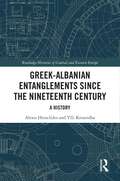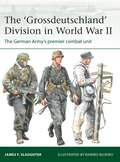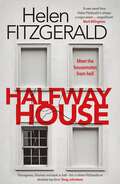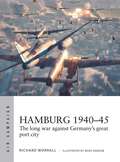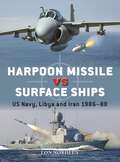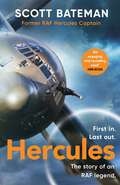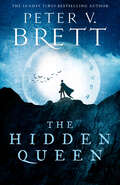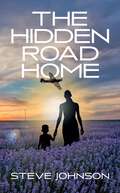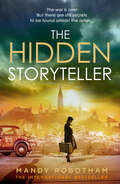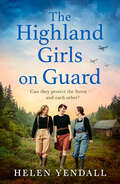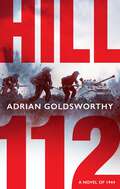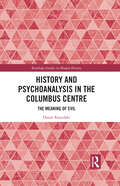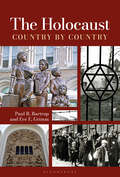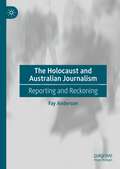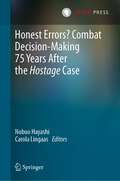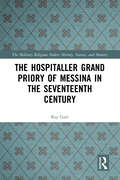- Table View
- List View
Greek-Albanian Entanglements since the Nineteenth Century: A History (Routledge Histories of Central and Eastern Europe)
by Alexis Heraclides Ylli KromidhaThis book is a comprehensive study of more than 200 years of the shared and interconnected histories of Greek-Albanian relations, a field of inquiry that has not attracted the international scholarly attention it deserves. The book presents and analyses in detail topics including the contested borderland (1800–1912), the Greek Revolution (1821–1830) and Greek-Albanian entanglements during it, Greek nationalism (identity and narrative), the Albanians (pre-modernism, belated nationalism, origin), the rise of Albanian nationalism, Albanian national identity and historical narrative, Greek-Albanian relations from the League of Prizren (1878) until Albania’s declaration of independence (1912), Greek irredentism (the "Northern Epirus Question", 1912–1920) and Albania’s precarious independence, Greek irredentism and Greek-Albanian relations (the "Northern Epirus Question", 1940–1971), the Greek minority in Albania, the Cham (Muslim Albanian) issue, the turbulent first part of the 1990s, the pending Greek-Albanian issues, and public opinion. It concludes with a road map for an eventual Albanian-Greek reconciliation. This volume will interest scholars and students of Southeastern Europe (Balkans), international and political history, political science and sociology. It will also be a valuable resource for diplomats, journalists, think tanks and other organizations and institutions involved in Greek-Albanian relations.
Greek-Albanian Entanglements since the Nineteenth Century: A History (Routledge Histories of Central and Eastern Europe)
by Alexis Heraclides Ylli KromidhaThis book is a comprehensive study of more than 200 years of the shared and interconnected histories of Greek-Albanian relations, a field of inquiry that has not attracted the international scholarly attention it deserves. The book presents and analyses in detail topics including the contested borderland (1800–1912), the Greek Revolution (1821–1830) and Greek-Albanian entanglements during it, Greek nationalism (identity and narrative), the Albanians (pre-modernism, belated nationalism, origin), the rise of Albanian nationalism, Albanian national identity and historical narrative, Greek-Albanian relations from the League of Prizren (1878) until Albania’s declaration of independence (1912), Greek irredentism (the "Northern Epirus Question", 1912–1920) and Albania’s precarious independence, Greek irredentism and Greek-Albanian relations (the "Northern Epirus Question", 1940–1971), the Greek minority in Albania, the Cham (Muslim Albanian) issue, the turbulent first part of the 1990s, the pending Greek-Albanian issues, and public opinion. It concludes with a road map for an eventual Albanian-Greek reconciliation. This volume will interest scholars and students of Southeastern Europe (Balkans), international and political history, political science and sociology. It will also be a valuable resource for diplomats, journalists, think tanks and other organizations and institutions involved in Greek-Albanian relations.
The 'Grossdeutschland' Division in World War II: The German Army's premier combat unit (Elite #255)
by Professor James F. SlaughterInvestigates the history and evolving appearance of the 'Grossdeutschland' Division, the German Army's premier combat unit during World War II. Featuring eight pages of original artwork and carefully chosen photographs depicting personalities, uniforms, insignia and personal equipment, this is the absorbing story of the German Army's elite 'fire brigade' during 1939–45. The unit began its life as an elite guard detachment; expanded to regimental size in 1939, it saw action in France in 1940 and Yugoslavia in 1941 before participating in the Axis invasion of the Soviet Union. Reinforced to divisional status, 'Grossdeutschland' fought on the Eastern Front in 1942–44, notably at Rzhev in late 1942 and Kharkov in early 1943. Refitted and redesignated a Panzergrenadier-Division, 'Grossdeutschland' played a key role in the battle of Kursk in July 1943, before acting as the Wehrmacht's 'fire brigade' in 1943–44. In late 1944, 'Grossdeutschland' was expanded to Panzerkorps status, with Panzergrenadier-Division 'Brandenburg' also taking the field. Further units joined the order of battle, the Führerbegleit-Brigade fighting in the Ardennes in 1944–45 before also being redesignated a division. All of these campaigns are covered in this book, which charts the evolving appearance of this elite formation over nearly six years of brutal warfare.
Ground Truth: The Moral Component in Contemporary British Warfare (Studies in Contemporary Warfare)
by Frank Ledwidge, Helen Parr & Aaron EdwardsAfter twenty years of almost unbroken wars of choice, the ethical deficiencies in the operational conduct of war by Western armed forces have largely been ignored by scholarly critique. This volume addresses these deficiencies, featuring analysis by some of the UK's leading academics and military veterans working in the fields of military ethics and contemporary conflict.Compiled in honour of Colonel David Benest OBE, a soldier-scholar who believed that ethics should be central to an effective military education, the book focuses on problems ranging from the practicalities of how to conduct a counterinsurgency campaign in one of the most challenging combat zones in the world to the failure to account properly for defeat during military conflicts. This important volume explores critical questions perennially raised about the role of the military in a democratic society and the extent to which its ideals are compromised in fighting wars of choice.
The Guernsey Girls Go to War: A heart-breaking historical novel of two friends torn apart by war (The Guernsey Girls)
by Mary WoodFrom the bestselling author of The Jam Factory Girls, comes the second heartfelt installment in Mary Wood's The Guernsey Girls trilogy.War separates them, but it cannot dampen their spirits . . .Spring, 1940. Annie’s new husband Ricky leaves to fight, but she soon discovers battles brewing closer to home. As her sister Janey begins to unravel, only Annie can pick up the pieces – and, with London’s police officers on the front line, she must also step up at work and do her bit for the country.In Guernsey, Olivia finds herself without her husband and son just as Hitler's forces invade the island. Trapped and heartbroken, she faces untold horrors as the Germans tighten their hold on the islanders.How will Annie manage her responsibilities to her family and her country in the thick of the Blitz, while suffering the heartache of not knowing what is happening to her beloved Ricky? And can Olivia survive in Guernsey at the hands of the enemy?
Halfway House: The Nerve-shatteringly Tense, Searingly Funny New Thriller From The Author Of Netflix Hit, The Cry
by Helen FitzGeraldOn her first shift at an Edinburgh halfway house for violent offenders, a young woman is taken hostage and turns to the residents for help. A twisty, shockingly dark thriller.When her disastrous Australian love affair ends, Lou heads to Edinburgh for a fresh start, moving in with her cousin. But after a week of partying, she starts the only job she can get ... working at a halfway house for very high-risk offendersOn her first solo night shift, Lou wakes to discover that she has been locked in her room, and is being held hostage. With no one to turn to but the other residents–all of them dangerous criminals–Lou is forced to rely on her own resources. Turns out, she’s excellent at negotiating ...and even better at killing.Slick, darkly funny and nerve-janglingly tense, Halfway House is both a breathtaking thriller and an unapologetic reminder never to corner a desperate woman...
Hamburg 1940–45: The long war against Germany's great port city (Air Campaign #44)
by Richard WorrallThe first book to cover the full history of the RAF's air war against Hamburg, one of the most important target cities in Germany. The city of Hamburg became synonymous with the destructive power of RAF Bomber Command when, during summer 1943, the city suffered horrific destruction in a series of four heavy firebombing attacks, Operation Gomorrah. However, few know how varied or long the Hamburg campaign was. In this book, RAF air power expert Dr Richard Worrall presents the complete history of the RAF's air campaign against the city, a campaign that stretched well beyond the devastating fire raids of 1943. Dr Worrall explains how Germany's second city was an industrial centre of immense proportions and proved a consistent target for Bomber Command throughout World War II. It was home to oil refineries, U-boat pens, and ship-building and submarine-building yards, all sustained by a large industrial workforce. Bomber Command evolved tactically and technically throughout the war, and the Luftwaffe's defensive capabilities would do likewise in response. Drawing on a wide range of primary and secondary sources available on this topic, and packed with photos, artwork, maps and diagrams, this is an important new history of the air campaign against the industrial and naval heart of Nazi Germany.
Harpoon Missile vs Surface Ships: US Navy, Libya and Iran 1986–88 (Duel #134)
by Lon NordeenAn illustrated study of premier US anti-ship missile, the AGM/RGM-84 Harpoon, and its 1986 and '88 uses against Libyan and Iranian naval vessels.In this study, defence technology expert Lon Nordeen details the role played by the Harpoon missile in two Cold War flare-ups in the 1980s. The Harpoon was the first tactical anti-ship missile developed by the US Navy to provide a counter to the anti-ship missiles exported around the world by the Soviet Union and China. It was deployed on ships, aircraft, submarines and land vehicles and soon became the most widely used anti-ship missile system in the West, with 7,000+ having been produced since 1977, operated by the military forces of more than 30 nations. This exciting book explores the engagements of the Harpoon by the US Navy against its Libyan and Iranian adversaries, using original photographs and specially commissioned artwork to examine the naval systems and weapons employed by both counterparts. Drawing upon interviews with the US Navy A-6 Intruder crews that deployed the AGM084 variant of the Harpoon in 1986 and 1988, the author brings unique insight to his examination of these fascinating duels.
Helmets and Body Armour in New Kingdom Egypt (Bloomsbury Egyptology)
by Alberto Maria PollastriniThis book examines the dynamics around the introduction and spread of helmets and body armour throughout Egypt during the 18th, 19th and 20th Dynasties. It argues that the word 'introduction' is the best term to define this phenomenon because these types of military equipment were not in fact Egyptian technological innovations, but initially appeared at the end of the Bronze Age following the Hurrian expansion in the Middle East before being dispersed throughout the surrounding territories. The analysis focuses particularly on a survey of iconographic, archaeological and lexicographic attestations from a wide range of surviving material evidence and literary sources. On the basis of the collated data, it provides as accurate a perspective as possible on how the helmet and the cuirass were introduced and propagated, their impact on warfare and their possible role in ideology across the chronological span of the New Kingdom. Pollastrini also draws productive comparisons between the Egyptian data and contemporary attestations from the Middle East and the Aegean region in order to underpin the 'international' dynamics at play. In doing so it both encourages a broader ancient-historical perspective that sets New Kingdom Egypt within its contemporary context, and sheds new light on developments in the military history and warfare of the period.
Hercules: An action-packed insider’s account of what it’s like to fly in the RAF's Hercules
by Scott BatemanRead the legendary story of the Lockheed C-130 Hercules aircraft, seen through the eyes of former RAF captain Scott Bateman'An engaging and revealing read' JOHN NICHOL---Anytime, Anywhere, Anyhow. Whether it’s war, natural disaster, or humanitarian emergency, for over fifty years the RAF’s Hercules force was the first in and last out of any crisis faced by the UK government around the globe.First conceived in the 1950s, the US-built Lockheed C-130 Hercules earned its spurs flying difficult and dangerous missions in the Vietnam War before entering service with air forces around the world. Originally designed as transport aircraft, the Hercules has been pressed into service as an aerial tanker, gunship, spyplane, air-sea rescuer and bomber.Instantly recognisable, it became synonymous with daring special forces missions like the legendary raid in Entebbe in which dozens of hostages were rescued from the clutches of terrorists. In RAF colours it's seen action on every continent on the planet including Antarctica, flying life and death missions in the Falklands, Lebanon, Iraq, Libya, Afghanistan, Sudan and all points in between.Former RAF Hercules Captain Scott Bateman opens the cockpit to give an action-packed insider’s account of what it’s like to fly this legendary flying machine in peace and war, and at home and abroad, paying tribute to the remarkable men and women who operated this much loved aircraft, and to those comrades in arms who, in doing so, made the ultimate sacrifice.
The Hidden Queen (The Nightfall Saga #2)
by Peter V. BrettThe second book in the Nightfall Saga, the stunning new epic fantasy series set in the world of the Demon Cycle, from New York Times bestselling author Peter V. Brett.
The Hidden Road Home
by Steve JohnsonLondon 1939. With a global conflict on the horizon, 19-year-old waitress, Charlotte Reid meets 21-year-old fighter pilot Tom Hammond. They soon realise that they have something special and after a short engagement, they marry, just after war with Germany is declared. The fall of France puts the Luftwaffe within striking range, and Tom in the thick of the action during the Battle of Britain. Both he and his young wife are taken through every nerve-shredding emotion as the fight for air superiority intensifies. If the Germans achieve their goal of totally destroying the RAF, then invasion would be the likely outcome. With fighter pilot casualty rates so high will Tom Hammond be one of the lucky ones or will the future he has planned with Charlotte literally go up in smoke? If that were to happen, how would she cope with grief at such a young age? Could she cope? War asks some tough questions of love. Is it stronger than fear? Stronger than hate? Stronger than death even? As the bloodiest conflict in history got underway, millions of people, including Tom and Charlotte, didn't know the answers. But they were about to find out.
The Hidden Storyteller
by null Mandy RobothamInternational bestselling author Mandy Robotham returns with a brand new tale set in war-torn Germany. The war is over. But there are still secrets to be found amidst the ashes . . . Hamburg, 1946 The war is over, and Germany is in ruins. Posted to an Allied-run Hamburg, reporter Georgie Young returns to the country she fled seven years prior – at the onset of the conflict – to find it unrecognisable. Amongst the stark horrors of a bombed-out city crumbling under the weight of millions of displaced souls, she discovers pockets of warmth: a violinist playing amidst the wreckage, couples dancing in the streets, and a nation trying to make amends. Joining forces with local detective Harri Schroder to catch a killer targeting women on the city’s streets, curiosity draws Georgie deep into the dark underbelly, and she soon discovers that some secrets of war did not die with Hitler… The next gripping and heart-wrenching historical fiction novel from international bestseller, Mandy Robotham. Readers love Mandy Robotham: ‘Evocative and emotive, a real must-read. Both harrowing and very moving. I couldn’t put it down’ Real Reader Review, ⭐⭐⭐⭐⭐ ‘I really liked the crime element in the story. This book will stay with me. Great writing – very poignant and heart-wrenching’ Real Reader Review, ⭐⭐⭐⭐⭐ ‘This is a really great book, full of interesting characters that you want to survive’ Real Reader Review, ⭐⭐⭐⭐⭐ ‘A thoroughly entertaining read. Strongly recommended’ Real Reader Review, ⭐⭐⭐⭐⭐ ‘Another excellent novel by Mandy Robotham! A thriller with a dash of historical fiction. It was very well written, and she had me on the edge of my seat the whole way through’ Real Reader Review, ⭐⭐⭐⭐⭐ ‘An informative, compassionate read of historical fiction. Highly recommended’ Real Reader Review, ⭐⭐⭐⭐⭐
The Highland Girls on Guard (The Highland Girls series #2)
by Helen Yendall‘Had me hooked from the start and I got so involved with the characters I couldn’t stop reading’ Vicki Beeby Scotland, 1943. It’s a long hot summer in Scotland but the Women’s Timber Corps have more than forest fires to worry about.
Hill 112: a novel of D-Day and the Battle of Normandy
by Adrian GoldsworthyA gripping story of friendship and division in the midst of warfare, set against one of the most dramatic, dangerous, and crucial campaigns of World War II: the Battle of Normandy. They went to war as boys. Will they make it home as men?D-Day. June 6th, 1944. The trajectory of the Second World War – and with it the course of modern history – is changed for ever.For three young former schoolmates from South Wales, their war is only just beginning.James was the school cricket captain. Now, a few short years later, he is in charge of a troop of Sherman tanks.Mark, just nineteen, must lead a platoon of infantrymen into battle.And Bill, always something of a loner, sees the heart of the fighting as a private soldier.These young men, and thousands of others, will soon be a part of one of the bloodiest and most brutal parts of the Normandy campaign: the battle for Hill 112. The horror, the fear, the filth; the savage fighting; the sheer exhilaration and moments of farce and laughter: those who come through the carnage will never be the same again.From critically acclaimed author and historian Adrian Goldsworthy, Hill 112 is based on real events and the records and reminiscences of those who were there. Published to coincide with the eightieth anniversary of D-Day, Hill 112 is perfect for fans of Robert Harris and Simon Scarrow.
History and Psychoanalysis in the Columbus Centre: The Meaning of Evil (Routledge Studies in Modern History)
by Danae KarydakiThis book draws on a range of key archives and oral testimonies to provide the first systematic and historical study of the origins, context, development, frustrations, inner contradictions, and legacies of the Columbus Centre. The Columbus Centre, a remarkable though largely forgotten research institute, was established at the University of Sussex in 1966, triggered by claims of a dearth of academic research about Nazism and the Holocaust. Its basic stated aim was to bring together psychoanalysis and history for a scholarly investigation of discrimination, mass violence, and the preconditions of genocide in the past and the present. The Nazi crimes were studied along with other instances of prejudice and mass violence, such as sixteenth- and seventeenth-century witch-hunts, South African apartheid, the persecution of the Roma people, and race relations in the United States and modern-day Britain. The book seeks to place the Columbus Centre in the historiography of mass violence by analysing the Centre’s works through four historiographical prisms or power relations in which they were produced: psychoanalysis, class, race, and gender. This interdisciplinary volume is a valuable text for scholars and students of historiography, psychoanalysis, genocide and violence, and postwar Europe, and for professionals within the field of psychology.
History and Psychoanalysis in the Columbus Centre: The Meaning of Evil (Routledge Studies in Modern History)
by Danae KarydakiThis book draws on a range of key archives and oral testimonies to provide the first systematic and historical study of the origins, context, development, frustrations, inner contradictions, and legacies of the Columbus Centre. The Columbus Centre, a remarkable though largely forgotten research institute, was established at the University of Sussex in 1966, triggered by claims of a dearth of academic research about Nazism and the Holocaust. Its basic stated aim was to bring together psychoanalysis and history for a scholarly investigation of discrimination, mass violence, and the preconditions of genocide in the past and the present. The Nazi crimes were studied along with other instances of prejudice and mass violence, such as sixteenth- and seventeenth-century witch-hunts, South African apartheid, the persecution of the Roma people, and race relations in the United States and modern-day Britain. The book seeks to place the Columbus Centre in the historiography of mass violence by analysing the Centre’s works through four historiographical prisms or power relations in which they were produced: psychoanalysis, class, race, and gender. This interdisciplinary volume is a valuable text for scholars and students of historiography, psychoanalysis, genocide and violence, and postwar Europe, and for professionals within the field of psychology.
The Holocaust: Country by Country
by Eve E. Grimm Professor Paul R. BartropFrom genocidal campaigns to careful neutrality to valiant lifesaving efforts, every country's experience of the Holocaust was different during and immediately following World War II.This book profiles 50 nations and territories from around the globe, examining how prewar conditions and attitudes toward Jews influenced the trajectory of that place's wartime experience and its role in the Holocaust. It also explores the aftermath and lasting impact of the Holocaust in these places. Each profile begins with a collection of at-a-glance facts about population, government leaders, wartime status, and more. All profiles begin with a brief introduction, followed by information about the Jewish population in that place, the prewar environment, wartime experiences, and the aftermath of the Holocaust. This standardized format makes it easy for readers to find specific information while also helping them place events within the proper historical context. A curated selection of further readings at the end of each profile and an end-of-volume list of books and Internet resources point readers toward materials for additional study.While often conceptualized as a single event that happened the same way across all Axis or Axis-occupied countries, the Holocaust and reactions to it varied widely from country to country. In many cases, political and economic conditions in the prewar years, as well as the degree of anti-Semitism in a nation, influenced that country's experience of the Holocaust. Even after the war, countries experienced the aftermath of the Holocaust in different ways. Some places, such as Palestine, became a beacon for Jewish refugees, while others, such as Brazil, became a hideout for Nazi war criminals.
The Holocaust and Australian Journalism: Reporting and Reckoning
by Fay AndersonThis book explores the Australian press reporting of the persecution and genocide of European Jews, and the extent to which the news of the Holocaust was known and believed, revealed and hidden, and acknowledged and minimised. Spanning the coverage of Hitler’s political ascent in the 1920s through to the Nazis’ extermination campaign, it culminates in the accounts of the trials of Nazi war criminals and the post-war transnational migration to Australia of Holocaust survivors, to a country far from universally welcoming in its reception of them. The book also tells the story of the journalists who reported on these tragic events and the editors who published them, along with the political, social and cultural context in which they worked, in an environment influenced by exclusionary ideas about race and nationality that did not necessarily inspire sympathy for Jews and their trauma. This book sheds light on the ethics of reporting human suffering, violence and genocide and – centrally – on the role of the press in shaping Australia’s collective memory of the Holocaust. It encourages readers to think critically about media power, public apathy, advocacy, and the importance of truth. Disturbing evidence of increasing anti-Semitism in Australia as elsewhere, along with continuing Holocaust denial, provide an additional urgency to this study.
Home front heroism: Civilians and conflict in Second World War London (Cultural History of Modern War)
by Ellena MatthewsHome front heroism investigates how civilians were recognised and celebrated as heroic during the Second World War. Through a focus on London, this book explores how heroism was manufactured as civilians adopted roles in production, protection and defence, through the use of uniforms and medals, and through the way that civilians were injured and killed.This book makes a novel contribution to the study of heroism by exploring the spatial, material, corporeal and ritualistic dimensions of heroic representations. By tracing the different ways that home front heroism was cultivated on a national, local and personal level, this study promotes new ways of thinking about the meaning and value of heroism during periods of conflict. It will appeal to anyone interested in the social and cultural history of Second World War as well as the sociology and psychology of heroism.
Home front heroism: Civilians and conflict in Second World War London (Cultural History of Modern War)
by Ellena MatthewsHome front heroism investigates how civilians were recognised and celebrated as heroic during the Second World War. Through a focus on London, this book explores how heroism was manufactured as civilians adopted roles in production, protection and defence, through the use of uniforms and medals, and through the way that civilians were injured and killed.This book makes a novel contribution to the study of heroism by exploring the spatial, material, corporeal and ritualistic dimensions of heroic representations. By tracing the different ways that home front heroism was cultivated on a national, local and personal level, this study promotes new ways of thinking about the meaning and value of heroism during periods of conflict. It will appeal to anyone interested in the social and cultural history of Second World War as well as the sociology and psychology of heroism.
Honest Errors? Combat Decision-Making 75 Years After the Hostage Case
by Nobuo Hayashi Carola LingaasThis book marks the 75th anniversary of the 1948 Hostage Case in which a US military tribunal in Nuremberg acquitted General Lothar Rendulic of devastating Northern Norway on account of his honest factual error. The volume critically reappraises the law and facts underlying his trial, the no second-guessing rule in customary international humanitarian law (IHL) that is named after the general himself, and the assessment of modern battlefield decisions.Using recently discovered documents, this volume casts major doubts on Rendulic’s claim that he considered the region’s total devastation and the forcible evacuation of all of its inhabitants imperatively demanded by military necessity at the time. This book’s analysis of court records reveals how the tribunal failed to examine relevant facts or explain the Rendulic Rule’s legal origin. This anthology shows that, despite the Hostage Case’s ambiguity and occasional suggestions to the contrary, objective reasonableness forms part of the reasonable commander test under IHL and the mistake of fact defence under international criminal law (ICL) to which the rule has given rise. This collection also identifies modern warfare’s characteristics—human judgment, de-empathetic battlespace, and institutional bias—that may make it problematic to deem some errors both honest and reasonable. The Rendulic Rule embodies an otherwise firmly established admonition against judging contentious battlefield decisions with hindsight. Nevertheless, it was born of a factually ill-suited case and continues to raise significant legal as well as ethical challenges today.The most comprehensive study of the Rendulic Rule ever to appear in English, this multi-disciplinary anthology will appeal to researchers and practitioners of IHL and ICL, as well as military historians and military ethicists and offers ground-breaking new research.Nobuo Hayashi is affiliated to the Centre for International and Operational Law at the Swedish Defence University in Stockholm, Sweden.Carola Lingaas is affiliated to the Faculty of Social Studies at VID Specialized University in Oslo, Norway.
The Hospitaller Grand Priory of Messina in the Seventeenth Century (ISSN)
by Ray GattThis book details the origin of the Grand Hospitaller Priory of Messina. It discusses a breadth of themes, such as the historiography, the Hospitaller’s European commandery and Sicilian patrimony, its management and organization in the seventeenth century, its religious practices, and the prioral mansion in Messina. The final chapter includes a detailed account of the 1674 Messina insurrection against the Spanish overlords. This event plunged the priory into political chaos, fracturing it and pitting members against each other. It also shattered neutrality issues embedded in the statutes of the religion and ignoring the precepts emanating from the Convent on Malta.The Hospitaller Grand Priory of Messina in the Seventeenth Century will appeal to students and scholars alike interested in the Crusading Orders, the history of the Knights Hospitaller, and the history of Malta.
The Hospitaller Grand Priory of Messina in the Seventeenth Century (ISSN)
by Ray GattThis book details the origin of the Grand Hospitaller Priory of Messina. It discusses a breadth of themes, such as the historiography, the Hospitaller’s European commandery and Sicilian patrimony, its management and organization in the seventeenth century, its religious practices, and the prioral mansion in Messina. The final chapter includes a detailed account of the 1674 Messina insurrection against the Spanish overlords. This event plunged the priory into political chaos, fracturing it and pitting members against each other. It also shattered neutrality issues embedded in the statutes of the religion and ignoring the precepts emanating from the Convent on Malta.The Hospitaller Grand Priory of Messina in the Seventeenth Century will appeal to students and scholars alike interested in the Crusading Orders, the history of the Knights Hospitaller, and the history of Malta.
How to Lose a War: The Story of America's Intervention in Afghanistan
by Amin SaikalAn incisive, authoritative account of the West’s failures in Afghanistan, from 9/11 to the fall of Kabul In 1958, Richard Nixon described Afghanistan as “unconquerable.” On 15 August 2021, he was proven right. After twenty years of intervention, US and NATO forces retreated, enabling the Taliban to return to power. Tens of thousands were killed in the long, unwinnable war, and millions more were displaced—leaving the future of Afghanistan hanging in the balance. Leading expert Amin Saikal traces the full story of America’s intervention, from 9/11 to the present crisis. After an initial swift military strike, the US became embroiled in a drawn-out struggle to change Afghanistan but failed to achieve its aims. Saikal shows how this failure was underlined by protracted attempts to capture Osama bin Laden, an inability to secure a viable government via “democracy promotion” efforts, and lack of wider strategy in the “war on terror.” How to Lose a War offers an insightful account of one of the US’s most significant foreign policy failures—and considers its dire consequences for the people of Afghanistan.
